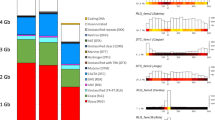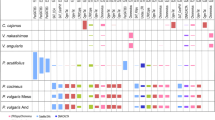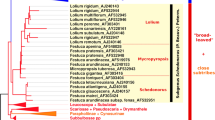Abstract
The chromosomal pattern of tandem repeat fractions of repetitive DNA is one of the most important characteristics of a species. In the present research, we aimed to detect and evaluate the level of intraspecific variability in the chromosomal distribution of species-specific Spelt 1 and Aegilops-Triticum-specific Spelt 52 tandem repeats in Aegilops speltoides and in closely related diploid and polyploid species. There is a distinct eco-geographical gradient in Spelt 1 and Spelt 52 blocks abundance in Ae. speltoides. In marginal populations, the number of Spelt 1 chromosomal blocks could be 12–14 times lower than in the center of the species distribution. Also, in related diploid species, the abundance of Spelt 52 correlates with evolutionary proximity to Ae. speltoides. Finally, the B- and G-genomes of allopolyploid wheats have Spelt 1 chromosomal distribution patterns similar to those of the types of Ae. speltoides with poor and rich contents of Spelt 1, respectively. The observed changes in numbers of blocks of Spelt 1 and Spelt 52 tandem repeats along the eco-geographical gradient may due to their depletion in the marginal populations as a result of increased recombination frequency under stressful conditions. Alternatively, it may be accumulation of tandem repeats in conducive climatic/edaphic environments in the center of the species’ geographical distribution. Anyway, we observe a bidirectional shift of repetitive DNA genomic patterns on the population level leading to the formation of population-specific chromosomal patterns of tandem repeats. The appearance of a new chromosomal pattern is considered an important factor in promoting the emergence of interbreeding barriers.






Similar content being viewed by others
Abbreviations
- DAPI:
-
4′,6′-Diamidino-2-phenylindole
- FISH:
-
Fluorescent in situ hybridization
- GISH:
-
Genomic in situ hybridization
References
Anamthawat-Jonsson K, Heslop-Harrison JS (1993) Isolation and characterization of genome-specific DNA sequences in Triticeae species. Mol Gen Genet 240:151–158
Anderson JA, Ogihara Y, Sorrels ME, Tanksley SD (1992) Development of a chromosomal arm map for wheat based on RFLP markers. Theor Appl Genet 83:1035–1043
Ankory H, Zohary D (1962) Natural hybridization between Aegilops sharonensis and Ae. longissima: a morphological and cytological study. Cytologia 27:314–324
Badaeva ED, Zoshchuk SA, Paux E, Gay G, Zoshchuk NV, Roger D, Zelenin AV, Bernard M, Feuillet C (2010) Fat element - a new marker for chromosome and genome analysis in the Triticeae. Chromosome Res 18:697–709
Badaeva ED, Friebe B, Gill BS (1996) Genome differentiation in Aegilops. 2. Physical mapping of 5S and 18S–26S ribosomal RNA gene families in diploid species. Genome 39:1150–1158
Baum B, Bailey G (2001) The 5S rRNA gene sequence variation in wheats and some polyploid wheat progenitors (Poaceae: Triticeae). Genet Resour Crop Evol 48:35–51
Belyayev A, Raskina O (1998) Heterochromatin discrimination in Aegilops speltoides by simultaneous genomic in situ hybridization. Chromosome Res 6:559–565
Belyayev A, Raskina O, Korol A, Nevo E (2000) Coevolution of A and B genomes in allotetraploid Triticum dicoccoides. Genome 43:1021–1026
Belyayev A, Kalendar R, Brodsky L, Nevo E, Schulman AH, Raskina O (2010) Transposable elements in a marginal plant population: temporal fluctuations provide new insights into genome evolution of wild diploid wheat. Mobile DNA 1:6
Carchilan M, Kumke K, Mikolajewski S, Houben A (2009) Rye B chromosomes are weakly transcribed and might alter the transcriptional activity of A chromosome sequences. Chromosoma 118:607–616
Cebria A, Navarro ML, Puertas MJ (1994) Genetic control of B chromosome transmission in Aegilops speltoides (Poaceae). Amer J Bot 81:1502–1507
Da Cunha AB, Dobzhansky T (1954) A further study of chromosomal polymorphism in Drosophila willistoni in its relation to the environment. Evolution 8:119–134
Daud HM, Gustafson JP (1996) Molecular determination of a B genome progenitor of wheat (Triticum aestivum) using a genome-specific repetitive DNA sequence. Genome 39:543–548
Devos KM (2010) Grass genome organization and evolution. Curr Opin Plant Biol 13:139–145
Devos KM, Dubcovsky J, Dvořák J, Chinoy CN, Gale MD (1995) Structural evolution of wheat chromosomes 4A, 5A, and 7B and its impact on recombination. Theor Appl Genet 91:282–288
Dvořák J, Zhang HB (1990) Variation in repeated nucleotide sequences sheds light on the origin of the wheat B and G genomes. Proc Natl Acad Sci USA 87:9640–9644
Dvořák J, Zhang HB (1992) Reconstruction of the phylogeny of the genus Triticum from variation in repeated nucleotide sequences. Theor Appl Genet 84:419–429
Feldman M, Kislev M (1977) Aegilops searsii, a new species of section Sitopsis (Platystachys). Israel J Bot 26:190–201
Feldman M, Levy AA (2005) Allopolyploidy - a shaping force in the evolution of wheat genomes. Cytogenet Gen Res 109:250–258
Flavell RB, Gale M, O’Dell M, Murphy G, Moore G, Lucas H (1993) Molecular organization of genes and repeats in the large cereal genomes and implications for the isolation of genes by chromosome walking. Chromosomes Today 11:199–214
Gerlach WL, Bedbrook JR (1979) Cloning and characterization of ribosomal RNA genes from wheat and barley. Nucleic Acids Res 7:1869–1885
Giorgi D, D’Ovidio R, Tanzarella OA, Ceoloni C, Porceddu E (2003) Isolation and haracterization of S genome specific sequences from Aegilops sect. Sitopsis species Genome 46:478–489
Grant V (1981) Plant speciation, 2nd edn. Columbia University Press, New York
Hoffmann AA, Sgrò CM, Weeks AR (2004) Chromosomal inversion polymorphisms and adaptation. Trends Ecol Evol 19:482–488
Jiang J, Gill BS (1994a) New 18S-26S ribosomal RNA gene loci: chromosomal landmarks for the evolution of polyploid wheats. Chromosoma 103:179–185
Jiang J, Gill BS (1994b) Different species-specific chromosome translocations in Triticum timopheevii and T. turgidum support diphyletic origin of polyploid wheats. Chromosome Res 2:59–64
Jones N, Houben A (2003) B chromosomes in plants: escapees from the A chromosome genome? Trends Plant Sci 8:417–423
Jones RN, González-Sánchez M, González-Garciía M, Vega JM, Puertas MJ (2008a) Chromosomes with a life of their own. Cytogenet Genome Res 120:265–280
Jones RN, Viegas W, Houben A (2008b) A century of B chromosomes in plants: so what? Ann Bot 101:767–775
Kimber G, Feldman M (1987) Wild Wheat, an Introduction. College of Agriculture University Missouri, Columbia
King IP, Pordie KA, Liu CJ, Reader SM, Pittaway TS, Orford SE, Miller TE (1994) Detection of interchromosomal translocations within the Triticeae by RFLP analysis. Genome 37:882–887
Kirkpatrick M, Barton N (2006) Chromosome inversions, local adaptation and speciation. Genetics 173:419–434
Lamb JC, Birchler JA (2006) Retroelement genome painting: cytological visualization of retroelement expansions in the genera Zea and Tripsacum. Genetics 173:1007–1021
Lamb JC, Yu W, Han F, Birchler JA (2007) Plant chromosomes from end to end: telomeres, heterochromatin and centromeres. Curr Opin Plant Biol 10:116–122
Levin DA (2002) The role of chromosomal change in plant evolution. Oxford University Press, New York
Lewis H (1962) Catastrophic selection as a factor in speciation. Evolution 16:257–271
Lewis H, Raven PH (1958) Rapid evolution in Clarkia. Evolution 12:319–336
Lippman Z, Gendrel AV, Black M, Vaughn MW, Dedhia N, McCombie WR, Lavine K, Mittal V, May B, Kasschau KD, Carrington JC, Doerge RW, Colot V, Martienssen R (2004) Role of transposable elements in heterochromatin and epigenetic control. Nature 430:471–476
Liu CJ, Atkinson MD, Chinoy CN, Devos KM, Gale MD (1992) Nonhomoeologous translocations between group 4, 5, and 7 chromosomes within wheat and rye. Theor Appl Genet 83:305–312
Lynch M, Conery JS (2003) The origins of genome complexity. Science 302:1401–1404
Maestra B, Naranjo T (1999) Structural chromosome differentiation between Triticum timopheevii and T. turgidum and T. aestivum. Theor Appl Genet 98:744–750
Maestra B, Naranjo T (2000) Genome evolution in Triticeae. Chromosomes Today 13:155–167
Martienssen R (2008) Great leap forward? Transposable elements, small interfering RNA and adaptive Lamarckian evolution. New Phytol 179:570–572
Mayr E (1942) Systematics and the origin of species. Columbia University Press, New York
Mendelson D, Zohary D (1972) Behavior and transmission of supernumerary chromosomes in Aegilops speltoides. Heredity 29:329–339
Miyashita NT, Mori N, Tsunewaki K (1994) Molecular variation in chloroplast DNA regions in ancestral species of wheat. Genetics 137:883–889
Mori N, Liu YG, Tsunewaki K (1995) Wheat phylogeny determined by RFLP analysis of nuclear DNA. 2. Wild tetraploid wheat. Theor Appl Genet 90:129–134
Naranjo T (1990) Chromosome structure of durum wheat. Theor Appl Genet 79:397–400
Puertas MJ (2002) Nature and evolution of B chromosomes in plants: a non-coding but information-rich part of plant genomes. Cytogenet Genome Res 96:198–205
Raskina O, Belyayev A, Nevo E (2002) Repetitive DNAs of wild emmer wheat Triticum dicoccoides and their relation to S-genome species: molecular-cytogenetic analysis. Genome 45:391–401
Raskina O, Belyayev A, Nevo E (2004a) Activity of the En/Spm-like transposons in meiosis as a base for chromosome repatterning in a small, isolated, peripheral population of Aegilops speltoides Tausch. Chromosome Res 12:153–161
Raskina O, Belyayev A, Nevo E (2004b) Quantum speciation in Aegilops: Molecular cytogenetic evidence from rDNA cluster variability in natural populations. Proc Natl Acad Sci USA 101:14818–14823
Rieseberg L, Willis JH (2007) Plant Speciation. Science 317:910–914
Riley R, Unrau J, Chapman V (1958) Evidence on the origin of the B genome of wheat. J Heredity 49:91–98
Rodrígues S, Maestra B, Perera E, Díez M, Naranjo T (2000a) Pairing affinities of the B- and G-genome chromosomes of polyploid wheats with those of Aegilops speltoides. Genome 43:814–819
Rodrígues S, Perera E, Maestra B, Díez M, Naranjo T (2000b) Chromosome structure of Triticum timopheevii relative to T. turgidum. Genome 43:923–930
Salina EA, Pestsova EG, Vershinin AV (1997) Spelt1 - new family of cereal tandem repeats. Russian J Genet 33:352–357
Salina EA, Numerova OM, Ozkan H, Feldman M (2004) Alterations in subtelomeric tandem repeats during early stages of allopolyploidy in wheat. Genome 47:860–867
Salina EA, Lim YL, Badaeva ED, Shcherban AB, Adonina IG, Amosova AV et al (2006) Phylogenetic reconstruction of Aegilops section Sitopsis and the evolution of tandem repeats in the diploids and derived wheat polyploids. Genome 49:1023–1035
Sarkar P, Stebbins GL (1956) Morphological evidence concerning the origin of the B genome in wheat. Am J Bot 43:297–304
Sears E (1941) Amphidiploids in the seven-chromosome Triticina. Univ Missouri Agric Exper Sta Res Bull 336:1–46
Sharma S, Raina SN (2005) Organization and evolution of highly repeated satellite DNA sequences in plant chromosomes. Cytogenet Genome Res 109:15–26
Wang G-Z, Miyashita NT, Tsunewaki K (1997) Plasmon analyses of Triticum (wheat) and Aegilops PCR-single-strand conformational polymorphism (PCR-SSCP) analyses of organellar DNAs. Proc Natl Acad Sci USA 94:14570–14577
Zarchi Y, Hillel J, Simchen G (1974) Supernumerary chromosomes and chiasma distribution in Triticum speltoides. Heredity 33:173–180
Zohary M (1970) Botany. In: Amiran DHK, Elster J, Gilead M, Rosenan N, Kadmon N, Parah U (eds) Atlas of Israel. Elsevier, Amsterdam
Zohary D, Imber D (1963) Genetic dimorphism in fruit types in Aegilops speltoides. Heredity 18:223–231
Zohary D, Harlan JR, Vardi A (1969) The wild diploid progenitors of wheat and their breeding value. Euphytica 18:58–65
Zoshchuk SA, Badaeva ED, Zoshchuk NV, Adonina IG, Shcherban AB, Salina EA (2007) Intraspecific divergence in wheats of the Timopheevi group as revealed by in situ hybridization with tandem repeats of the Spelt1 and Spelt52 families. Russian J Genet 43:771–781
Acknowledgments
We thank Hanan Sela for his help in collecting plant material. We are most grateful to Moshe Feldman and Estella Nazarova for kindly supplying seeds. We thank anonymous reviewers for the helpful comments. This work is supported by the Israel Science Foundation under grant number 723/07.
Author information
Authors and Affiliations
Corresponding author
Additional information
Responsible Editor: Pat Heslop-Harrison
Electronic supplementary material
Below is the link to the electronic supplementary material.
ESM 1
(DOC 44.0 kb)
Fig. 7
a The bi-partite clustering of genotypes based on 28 Spelt 1 tandem repeats features (counts of blocks in 28 chromosome arms of the diploid genome). 1 Central and intermediate populations; 2 marginal populations. This clustering unites clusters I (intermediate populations) and C (central populations) of Fig. 2a, and separates them from cluster M (marginal populations). Such a clustering corresponds to the first discrimination function of LDA (supplementary Table 4). b The clustering silhouette widths for individual genotypes (dark blue bars) and predicted classes (yellow bars) for the bi-partite clustering according to Spelt 1 blocks features (JPEG 28 kb)
Fig. 8
a The bi-partite clustering of genotypes that is based on twenty eight Spelt 52 tandem repeats features. 1 Marginal and intermediate populations; 2 central populations. This clustering united clusters M and I of Fig. 2a and separated them from cluster C. Such a clustering corresponded to the second discrimination function of LDA. b The clustering silhouette widths for individual genotypes (dark blue bars) and predicted classes (yellow bars) for the bi-partite clustering according to the Spelt 52 tandem repeats features. (JPEG 29 kb)
Rights and permissions
About this article
Cite this article
Raskina, O., Brodsky, L. & Belyayev, A. Tandem repeats on an eco-geographical scale: outcomes from the genome of Aegilops speltoides . Chromosome Res 19, 607–623 (2011). https://doi.org/10.1007/s10577-011-9220-9
Received:
Revised:
Accepted:
Published:
Issue Date:
DOI: https://doi.org/10.1007/s10577-011-9220-9




